Non-association independent schools inspections and outcomes official statistics as at 31 August 2017: main findings
Updated 18 December 2019
This release contains:
-
provisional data for inspections completed between 1 September 2016 and 31 August 2017
-
most recent inspections and outcomes as at 31 August 2017
-
revised data for inspections completed between 1 September 2016 and 31 March 2017
Non-association independent school inspection outcomes continue to decline.
At the end of August 2017, 68% of schools inspected were judged good or outstanding at their most recent inspection. This is 4 percentage points lower than the proportion judged good or outstanding as at 31 August 2016.
Figure 1: Most recent overall effectiveness outcomes of non-association independent schools as at 31 August 2017

Special schools are performing more strongly than other independent schools.
Seventy-eight per cent of special schools were judged good or outstanding compared with 60% of other independent schools. Only 9% of special schools were judged inadequate compared with 19% of other independent schools.
There are a combination of reasons for the continued decline in inspection outcomes over a number of years.
Reasons include the poor outcomes for some faith schools; concerns about safeguarding; schools failing to meet the new standards introduced by the Department for Education and schools taking too long to improve.
1. Schools at their most recent inspection
On 31 August 2017 there were 1,080 open non-association independent schools. Ofsted has inspected 977 of these.[footnote 1] Sixty-eight per cent were judged good or outstanding, 18% were judged requires improvement and 14% were inadequate at their most recent inspection. The proportion of schools judged good or outstanding is 4 percentage points lower than the position at 31 August 2016.
Figure 2: Most recent overall effectiveness of non-association independent schools as at 31 August 2017, by type
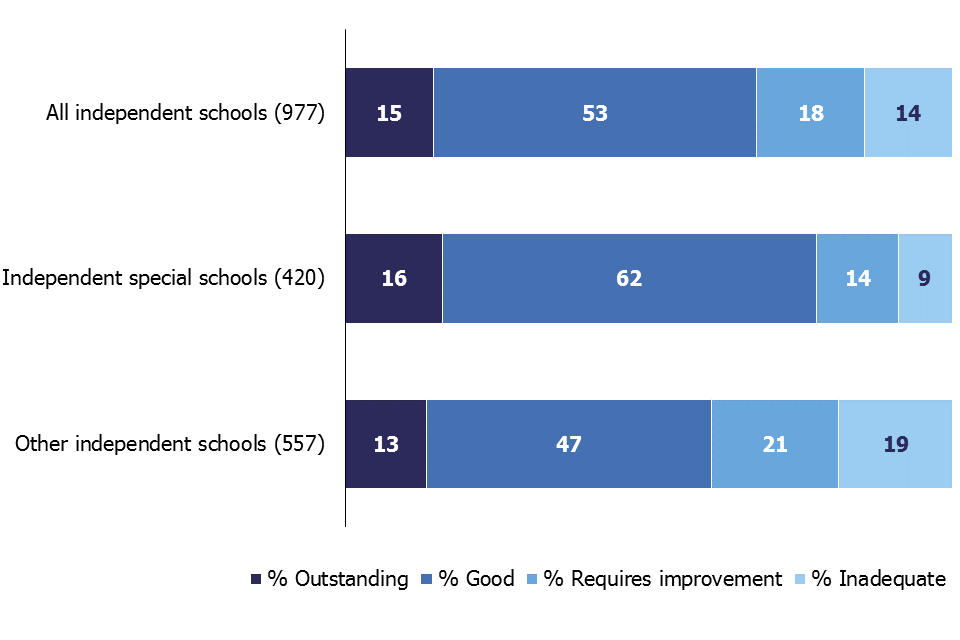
Around two-fifths of the schools that we inspect are special schools. They are performing more strongly than other independent schools (private schools catering for primary or secondary aged pupils, or catering for both age groups). Seventy-eight per cent of special schools were judged good or outstanding compared with 60% of other schools. Only 9% of special schools were judged inadequate compared with 19% of other independent schools.
The proportion of special schools judged good or outstanding has improved over recent years, from 74% in 2014 to 78% in 2017. However, the decline in inspection outcomes for other independent schools over the same period has been quite stark. The proportion of these schools which are good or outstanding at their most recent inspection has fallen from 79% in 2014, to 60% in 2017.
Figure 3: Proportion of non-association independent schools judged good or outstanding at their most recent inspection, 31 August 2017, by type
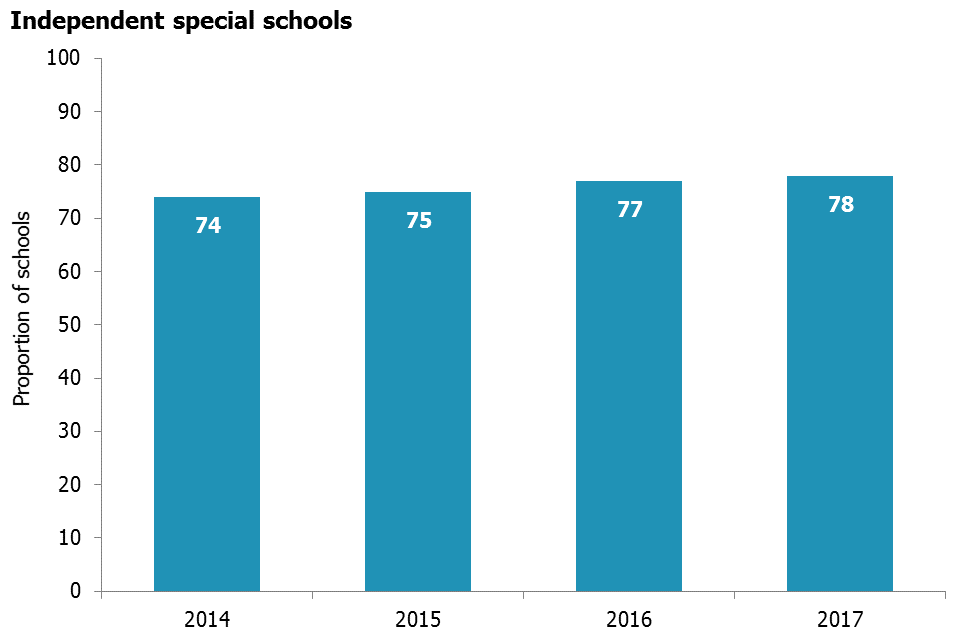
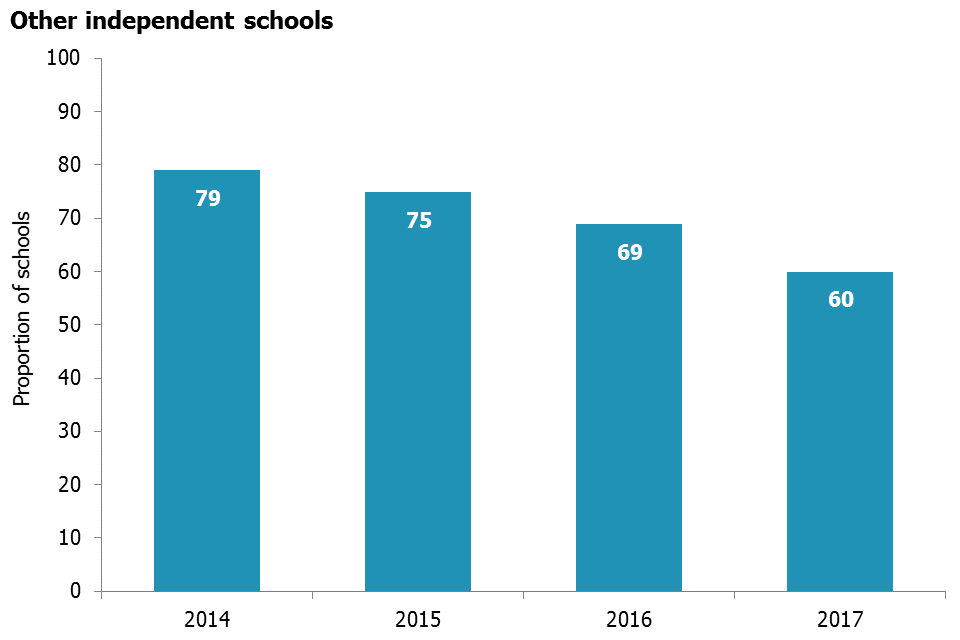
2. Inspections between 1 September 2016 and 31 March 2017
Between 1 September 2016 and 31 August 2017, Ofsted carried out 337 standard inspections.[footnote 2] Over a fifth of these (72 schools) were judged to be inadequate (Figure 4), with 60 also being found ineffective for safeguarding.
Figure 4: Overall effectiveness of non-association independent schools inspected in each year since 1 September 2009
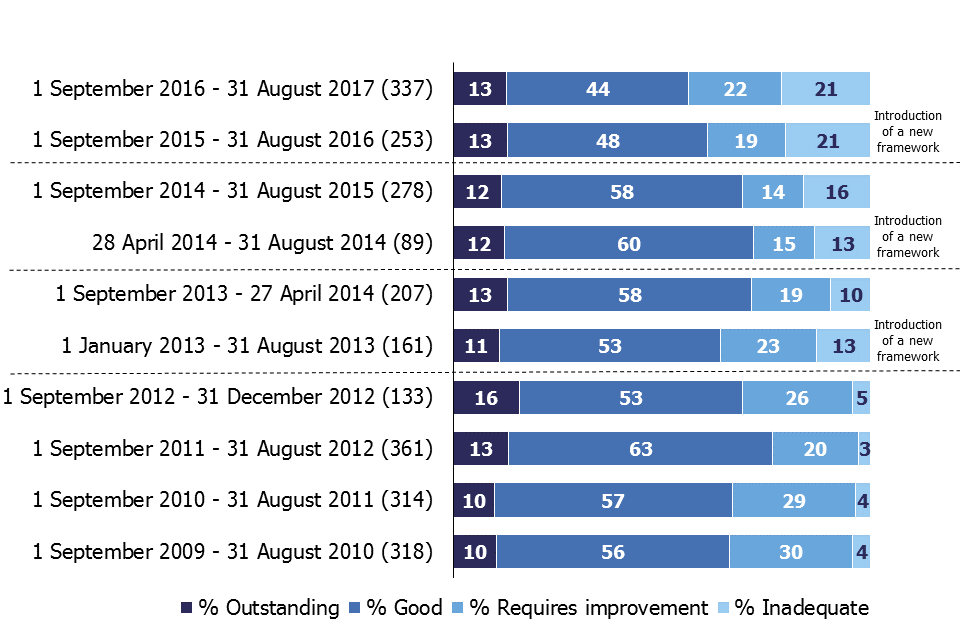
The proportion of schools judged less than good has been increasing over a number of years. This is driven by outcomes for other independent schools, where over half of schools (103 of the 189 schools inspected) were judged to be less than good in the academic year to August 2017 (the current academic year). In comparison, outcomes for independent special schools were stronger, with just under a third (43 of the 148 inspections) of schools judged less than good this year.
Of the 337 schools inspected, 287 have had a previous inspection. Of these, 108 (38%) declined from their previous inspection, 124 (43%) remained at the same grade, and only 55 (19%) improved on their judgement.
3. Compliance with independent school standards
Ofsted checks and reports on the extent to which schools meet the independent school standards. The percentage of standard inspections where the school was meeting all requirements has decreased from 74% in the academic year to August 2015, to 66% in the current academic year.
Table 1: Compliance with standards of non-association independent schools inspected and judged inadequate in the academic year to August 2017
| Met the standard (No.) | Did not meet the standard (No.) | |
|---|---|---|
| Part 1: Quality of education | 20 | 52 |
| Part 2: Spiritual, moral, social and cultural education of pupils | 50 | 22 |
| Part 3: Welfare, health and safety of pupils | 8 | 64 |
| Part 4: Suitability of the proprietor, staff and supply staff | 33 | 39 |
| Part 5: Premises and accommodation of schools | 37 | 35 |
| Part 6: Provision of information for parents, carers and others | 41 | 31 |
| Part 7: Manner in which complaints are to be handled | 54 | 18 |
| Part 8: Quality of leadership and management | 1 | 71 |
Of the 72 schools judged inadequate this year, all but one failed to meet standards associated with leadership and management (71). Many also failed to meet the standards for the welfare health and safety of pupils (64) and the quality of education (52).
Ofsted also carries out progress monitoring inspections of schools judged not to have met all standards at their last inspection. The progress made towards these standards has been poor in the current academic year. Of the 138 progress monitoring inspections this year, only 78 schools have now improved to meet the standards checked on these inspections.
4. Reasons for decline
Over the last few years the proportion of non-association independent schools judged good or outstanding at their most recent inspection has declined. At the end of August 2017, 141 schools (14%) were judged inadequate at their most recent inspection. This compares with only 43 schools (4%) at August 2014.
This decline is caused by a combination of:
- schools failing to meet the new standards introduced by the Department for Education (DfE) from September 2014
- safeguarding concerns
- a sharp decline in inspection outcomes for other independent schools and more specifically faith schools, compounded by the number of faith schools inspected by Ofsted increasing in the period
- failing schools taking too long to improve
4.1 Standards for independent schools
More schools are failing standards. The DfE introduced new standards for independent schools from September 2014 (supplemented in January 2015). In the year before the standards were introduced, 79% of schools inspected met all standards, compared with just 66% in the current academic year.
These standards included a new section on leadership and management (Part 8), but also included a focus on fundamental British values. The new standards on fundamental British values look at requirements in relation to written policies on the curriculum (requirement 2(1)(b)(ii)), the quality of teaching (requirement 3(i)) and the spiritual, moral, social and cultural development of pupils (requirement 5(a)). While numbers are small, a higher proportion of the weaker faith schools are failing on these requirements when compared to those with no faith (Table 2).
Table 2: Fundamental British values and leadership and management: non-association independent schools inspected and judged requires improvement or inadequate between September 2015 and August 2017
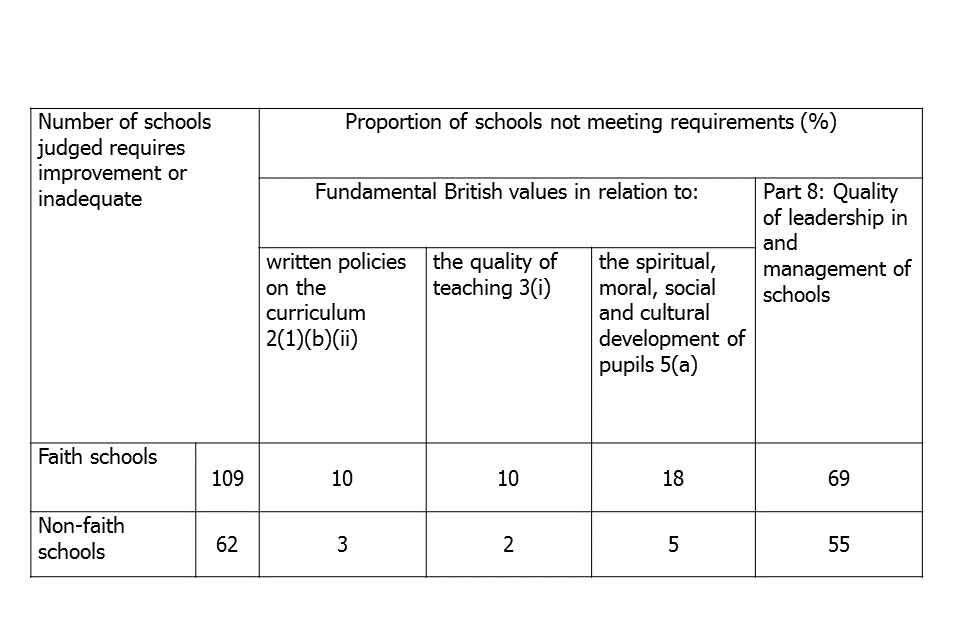
4.2 Safeguarding
Safeguarding is also of particular concern. Since September 2015, independent schools have been inspected under the common inspection framework, which holds them to account in similar ways to maintained schools and academies for the quality of their work. During this period we have found safeguarding to be ineffective in 17% of all schools inspected. Of the 124 independent schools judged inadequate, 98 have had ineffective safeguarding.
4.3 Faith schools
There has been a sharp decline in inspection outcomes for other independent schools and in particular schools with a faith. Almost half of faith schools (49%) were judged less than good at their most recent inspection and over a quarter (26%) were inadequate. However there is a lot of variation within the different faith groups (Figure 5).
The number of faith schools inspected by Ofsted has increased over the last few years. Ofsted now inspects schools previously inspected by the Bridge Schools Inspectorate (BSI). These schools are Christian and Muslim schools. We have inspected 39 of the 51 former BSI schools in the last 2 years. Twenty eight of these schools have been judged to be less than good. The inspection of these schools has caused a far larger fall in the proportion judged good or better than would otherwise have been expected. Ofsted plan to inspect all non-association independent schools under the common inspection framework by August 2018.
Figure 5: Overall effectiveness of non-association independent schools at their most recent inspection, by faith, 31 August 2017 (numbers of schools)

4.4 Schools’ capacity to improve
Failing schools are taking too long to improve. Of the 141 non-association schools that are currently inadequate, over a quarter (26%) have been inadequate for over 2 years. Since September 2015, around three-fifths (61%) of action plans submitted to the DfE by schools were not considered to be good enough.
Also, almost half (47%) of progress monitoring inspections of schools during the same period did not meet the standards being checked. While some schools (53%) met the standards checked on a progress monitoring inspection, they remain inadequate until their next standard inspection, where a full review of all standards is completed.
5. Revisions to previous release
Provisional data indicated that there were 198 inspections between 1 September 2016 and 31 March 2017 (published by 30 April 2017). Revised data shows that there were an additional 19 inspections which were published after 30 April 2017. Three of these schools were judged outstanding, 7 schools were judged good, 4 schools were judged requires improvement and 5 schools were inadequate.
The addition of these inspections changed the profile of overall effectiveness. The proportion of schools judged good fell by one percentage point from 43% to 42% and those schools judged inadequate increased from 22% to 23%. Further details can be found in the revised tables in the charts and tables file accompanying this release.
6. Response to the consultation on changes to the release of statistics on non-association independent schools
Between 20 July 2017 and 14 September 2017 Ofsted consulted on proposals to change the frequency of publishing statistics on inspections and outcomes for non-association independent schools. Our proposals include publishing management information on a regular basis.
Respondents supported these proposals. Based on these findings, we will make all of the changes proposed as part of the consultation. We will not publish the official statistics publication previously planned for June 2018. The next publication will now be in November 2018. We will begin publishing additional management information from early 2018.
7. Ofsted’s Annual Report
Findings from our forthcoming Annual Report will be published on 13 December 2017.
8. Notes
Data in this release is from inspections undertaken between 1 September 2016 and 31 August 2017 and most recent inspections of open schools at 31 August 2017, where the inspection report was published by 30 September 2017. If an inspection report is not published by 30 September 2017 then the previous inspection, where available, will be reported as the school’s most recent inspection.
From September 2015, data in this official statistics release reflects judgements made on inspections conducted under sections 99, and 109 (1) and (2) of the Education and Skills Act 2008. The regulations set out the standards on which inspectors report. This includes the extent to which the school meets the requirements of the Education (Independent School Standards) Regulations 2014 (referred to as the independent school standards).
The accompanying methodology and quality report for this release sets out the main uses of this data, further contextual information and arrangements for quality assurance. It also provides information about strengths and limitations of the statistics.
In 2016, the National Statistician published new guidance covering management information and official statistics.
9. Glossary
9.1 Independent school standards regulations
Section 94 of the Education and Skills Act 2008 specifies that the Secretary of State must set out in regulations the standards that independent schools must meet. The standards must be about: quality of education; spiritual, moral, social and cultural development of pupils; welfare, health and safety of pupils; suitability of staff and proprietors; premises and accommodation at the school; provision of information; the manner in which complaints are to be handled; and the quality of leadership and management.
The standards are set out in The Education (Independent School Standards) Regulations 2014, which specify the provision a school must make. Schools must meet these standards in order to register, and to continue to be registered, as independent schools.
9.2 Independent schools
Independent schools are defined by section 463 of the Education Act 1996, as amended. They provide full-time education for:
- 5 or more pupils of compulsory school age, or
- at least one pupil of that age for whom a statement is maintained under section 324, or who is looked after by a local authority (within the meaning of section 22 of the Children Act 1989)
It is immaterial if full-time education is also provided at the school for pupils under or over compulsory school age.[footnote 4]
Part A of the departmental advice Registration of independent schools sets out the DfE’s policy on full time education.
Ofsted only inspects the quality of educational provision and compliance with independent school standards in non-association schools. These are schools that are not members of independent schools associations. Schools which are members of independent schools associations are inspected by inspectorates approved by the Secretary of State for this purpose: the Independent Schools Inspectorate and the School Inspection Service. All inspections are carried out at the request of the Secretary of State, which is the registration authority for all independent schools.
9.3 Inspection types
Ofsted conducts the following inspection types.
Pre-registration inspections
The Secretary of State is the registration authority for independent schools in England, and maintains a register of independent schools. When a proprietor has made an application for registration of an independent school the Secretary of State must notify HMCI, who must then inspect the school. The purpose of the inspection is to report to the registration authority on the extent to which the independent school standards are likely to be met if the school were to be registered. Such inspections are conducted under section 99 of the Education and Skills Act 2008.
When a proprietor makes an application for a new boarding or residential special school, an integrated pre-registration inspection is made by both an education and a social care inspector.
Standard inspections
Standard inspections of independent schools are conducted under sections 109 (1) and (2) of the Education and Skills Act 2008. Ofsted will report to the DfE on the extent to which the school complies with the independent school standards, and will also make evaluative judgements about the quality of education provided by the school under Ofsted’s common inspection framework. Ofsted will normally contact the school by telephone to announce the inspection around lunchtime on the day before the inspection is due to start.
Progress monitoring inspections
Ofsted conducts progress monitoring inspections at the request of the Secretary of State to check the progress made by independent schools to address weaknesses identified at their last inspection. These inspections are conducted under sections 109 (1) and (2) of the Education and Skills Act 2008.
Schools identified as having weaknesses are normally required to submit an action plan to the Secretary of State setting out the steps they will take to address their weaknesses and meet the relevant independent school standards and/or national minimum standards. Action plans must specify the timescale within which the steps will be taken.
In progress monitoring inspections, inspectors assess and report on the amount of progress schools have made with implementing their action plan. They will check whether the previously unmet independent school standards or national minimum standards are now met.
Emergency inspections
Emergency inspections of independent schools are conducted under sections 109(1) and (2) of the Education and Skills Act 2008. They are carried out at the request of the Secretary of State for a variety of reasons, for example as a result of a complaint or concern made known to the DfE. The issue that triggered the inspection will be used as the main line of enquiry for the inspection[footnote 5] and Ofsted will report to the DfE whether the school meets the independent school standards relevant to the issue. Emergency inspections are conducted without notice and reports of these inspections are only published at the request of the Secretary of State.
Material change inspections
Outside normal inspection cycles, Ofsted carries out material change inspections of registered independent schools at the request of the Secretary of State, when the school wishes to make a material change to their premises, intake or age range; the provision they make for disabled pupils and those with special educational needs; or there is a change to the proprietor. These inspections are conducted under section 162 of the Education Act 2002.
Inspectors will consider the implications of the material change and report to the Secretary of State whether the school is likely to meet the relevant independent school standards, if the material change is implemented. The school cannot implement the proposed change unless the Secretary of State grants permission.
10. Further information
10.1 Contact for comments or feedback
If you have any comments or feedback on this publication, please contact Louise Butler on 03000 131 457 or Louise.Butler@ofsted.gov.uk
10.2 Acknowledgements
Thanks to the following for their contribution to this statistical release: Tristan Browne, James Jordan, Jay Kerai, Austen Norris, and Michael Taylor.
-
Not all open schools have received a standard inspection. Once registered, new schools receive their first standard inspection in their first year of operation, at the request of the Department for Education (DfE). Two school inspections are excluded from the number of schools inspected. One school last had a full inspection prior to the introduction of an overall effectiveness judgement. Also, the current academic year one inspection gave no inspection judgements. ↩
-
There were 338 inspections carried out in the current academic year, but one inspection resulted in no inspection judgements being made. This inspection is excluded from the analysis of judgements. Compliance with the independent school standards was checked in this inspection. ↩
-
This definition of ‘independent school’ forms part of the definition of ‘an independent educational institution’ for the purpose of the 2008 Act. ↩
-
Ofsted does not investigate individual complaints. Rather, the focus of inspection are any issues that impact the whole school as a whole, that the complaint may give rise to. ↩

